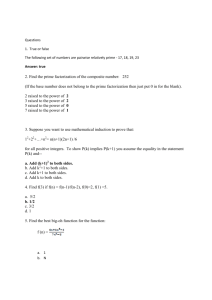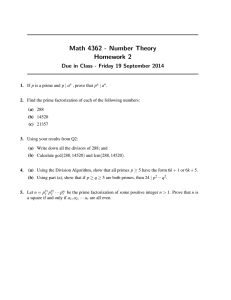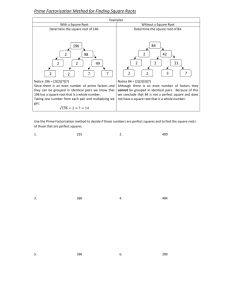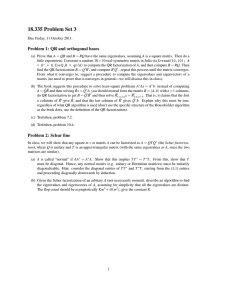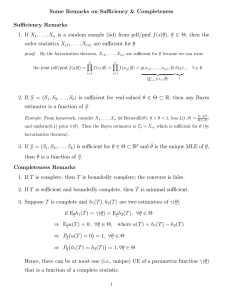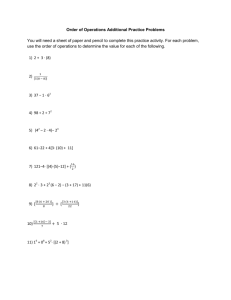#A52 INTEGERS 9 (2009), 699-702 FACTORIZATION RESULTS WITH COMBINATORIAL PROOFS Kereszt´ely Corr´adi
advertisement
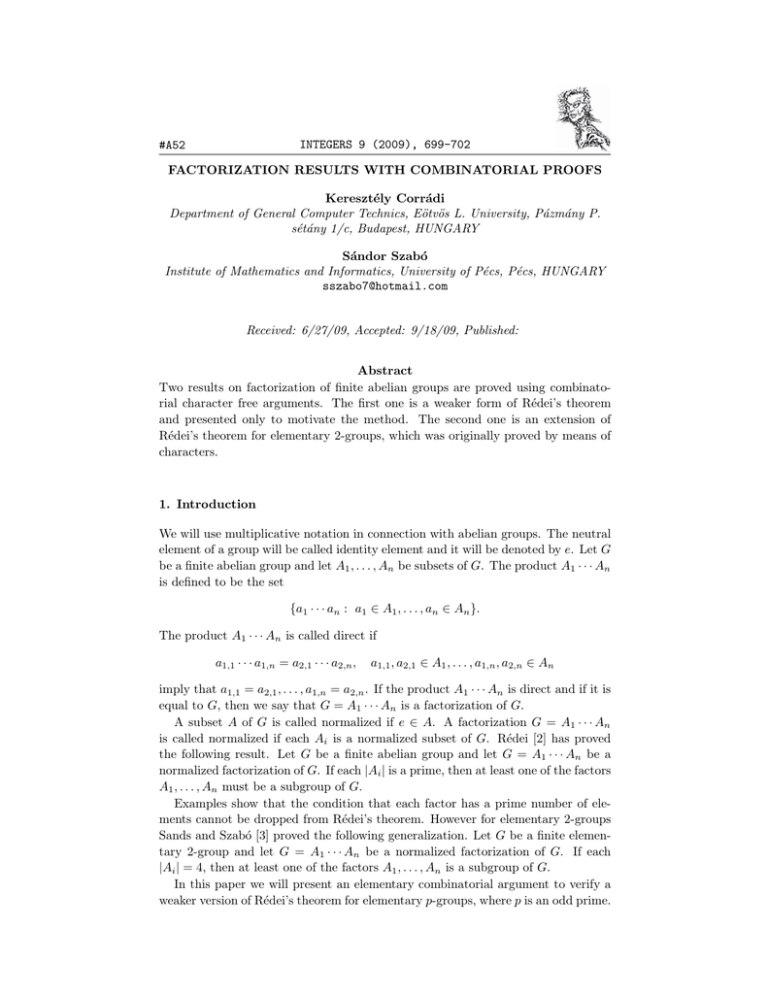
INTEGERS 9 (2009), 699-702
#A52
FACTORIZATION RESULTS WITH COMBINATORIAL PROOFS
Keresztély Corrádi
Department of General Computer Technics, Eötvös L. University, Pázmány P.
sétány 1/c, Budapest, HUNGARY
Sándor Szabó
Institute of Mathematics and Informatics, University of Pécs, Pécs, HUNGARY
sszabo7@hotmail.com
Received: 6/27/09, Accepted: 9/18/09, Published:
Abstract
Two results on factorization of finite abelian groups are proved using combinatorial character free arguments. The first one is a weaker form of Rédei’s theorem
and presented only to motivate the method. The second one is an extension of
Rédei’s theorem for elementary 2-groups, which was originally proved by means of
characters.
1. Introduction
We will use multiplicative notation in connection with abelian groups. The neutral
element of a group will be called identity element and it will be denoted by e. Let G
be a finite abelian group and let A1 , . . . , An be subsets of G. The product A1 · · · An
is defined to be the set
{a1 · · · an : a1 ∈ A1 , . . . , an ∈ An }.
The product A1 · · · An is called direct if
a1,1 · · · a1,n = a2,1 · · · a2,n ,
a1,1 , a2,1 ∈ A1 , . . . , a1,n , a2,n ∈ An
imply that a1,1 = a2,1 , . . . , a1,n = a2,n . If the product A1 · · · An is direct and if it is
equal to G, then we say that G = A1 · · · An is a factorization of G.
A subset A of G is called normalized if e ∈ A. A factorization G = A1 · · · An
is called normalized if each Ai is a normalized subset of G. Rédei [2] has proved
the following result. Let G be a finite abelian group and let G = A1 · · · An be a
normalized factorization of G. If each |Ai | is a prime, then at least one of the factors
A1 , . . . , An must be a subgroup of G.
Examples show that the condition that each factor has a prime number of elements cannot be dropped from Rédei’s theorem. However for elementary 2-groups
Sands and Szabó [3] proved the following generalization. Let G be a finite elementary 2-group and let G = A1 · · · An be a normalized factorization of G. If each
|Ai | = 4, then at least one of the factors A1 , . . . , An is a subgroup of G.
In this paper we will present an elementary combinatorial argument to verify a
weaker version of Rédei’s theorem for elementary p-groups, where p is an odd prime.
704
INTEGERS: 9 (2009)
Then applying the method to elementary 2-groups we obtain a combinatorial character free proof for the Sands-Szabó result.
2. Elementary p-groups
Let G be a finite abelian group of odd order. Let G = A1 · · · An be a normalized
factorization of G, where each |Ai | is a prime. By Rédei’s theorem at least one of
the factors A1 , . . . , An is a subgroup of G. Say Ai is a subgroup of G. Now as |Ai |
is odd, it follows that the product of the elements of Ai is equal to e. This indicates
that the following theorem is a weaker version of Rédei’s theorem. The essential
point is that we are able to give a combinatorial proof of this result.
Theorem 1 Let p be an odd prime. Let G be a finite elementary p-group and
let G = A1 · · · An be a normalized factorization of G, where |Ai | = p, for each i,
1 ≤ i ≤ n. Let
!
di =
a.
a∈Ai
Then di = e for some i, 1 ≤ i ≤ n.
Proof. Assume on the contrary that there is a counterexample
G = A1 · · · An ,
(1)
where none of the elements di is equal to e. For n = 1, the factor A1 is equal to G
and so d1 = e. Thus we may assume that n ≥ 2. Among the counterexamples we
choose one with minimal n.
We introduce the following notations. For each i, 1 ≤ i ≤ n let
Ai
Ui
Vi
Xi
di
= {e, ai,1 , . . . , ai,p−1 },
= $ai,1 %,
= $ai,2 %,
= Ui ∪ Vi ,
= ai,1 · · · ai,p−1 .
If Ai is a subgroup of G, then di = e. In the counterexample (1) di '= e and so Ai
is not a subgroup of G. In particular Ai '= Ui . We may choose the notation such
that ai,2 '∈ Ui . As a consequence, Ui '= Vi .
By Lemma 5 of [1], in the factorization (1) the factor A1 can be replaced by U1 ,
V1 to get the factorizations
G = U1 A2 · · · An ,
G = V1 A2 · · · An ,
(2)
(3)
705
INTEGERS: 9 (2009)
respectively. From (2), by considering the factor group G/U1 we get the factorization
G/U1 = (A2 U1 )/U1 · · · (An U1 )/U1
of G/U1 . Here
(Ai U1 )/U1 = {aU1 : a ∈ Ai }.
The minimality of the counterexample (1) forces that
di U1 =
!
aU1
a∈Ai
must be equal to eU1 for some i, 2 ≤ i ≤ n. Or equivalently di ∈ U1 must hold for
some i, 2 ≤ i ≤ n.
Starting with factorization (3) we get that there is an index j, 2 ≤ j ≤ n, such
that dj ∈ V1 .
If di = dj , then by di ∈ U1 ∩ V1 = {e} we end up with the di = e contradiction.
Thus di '= dj .
The argument above provides that for the index 1 there are indices α(1), β(1)
such that dα(1) , dβ(1) ∈ X1 and α(1) '= β(1). In general, for the index i, 1 ≤ i ≤ n
there are indices α(i), β(i) such that dα(i) , dβ(i) ∈ Xi and α(i) '= β(i).
By Lemma 5 of [1], in the factorization (1) the factor A1 can be replaced by
U1 to get the factorization G = U1 A2 · · · An . In this factorization the factor A2
can be replaced by U2 to get the factorization G = U1 U2 A3 · · · An . It follows that
U1 ∩ U2 = {e}. Similar arguments give that
U1 ∩ U2
V1 ∩ U2
= U1 ∩ V2
= V1 ∩ V2
= {e},
= {e}.
Therefore
X1 ∩ X2 = (U1 ∪ V1 ) ∩ (U2 ∪ V2 ) = {e}.
In general, Xi ∩ Xj = {e} for each i, j, 1 ≤ i, j ≤ n, i '= j.
Choose i, j such that 1 ≤ i, j ≤ n, i '= j. If α(i) = α(j), then dα(i) = dα(j)
and so dα(i) ∈ Xi ∩ Xj = {e} gives the dα(i) = e contradiction. Thus i '= j implies
α(i) '= α(j). Similar arguments give that i '= j implies
α(i) '= α(j), α(i) '= β(j),
β(i) '= α(j), β(i) =
' β(j).
In particular the indices α(1), . . . , α(n) form a permutation of the elements 1, . . . , n.
We know that α(1) '= β(1). Since α(1), . . . , α(n) is a permutation of 1, . . . , n, there
is an i, 2 ≤ i ≤ n, such that α(i) = β(1). This violates α(i) '= β(j).
The proof is complete.
!
706
INTEGERS: 9 (2009)
3. Elementary 2-groups
Theorem 1 is a weaker version of Rédei’s theorem for elementary p-groups where p
is an odd prime. The method of the proof of this theorem can be used to prove an
extension of Rédei’s theorem. First we present two lemmas.
Let G be a finite abelian group and let A = {e, u, v, w} be a subset of G such
that u2 = v 2 = w2 = e. Set
U
V
W
X
= $v, w%,
= $u, w%,
= $u, v%,
= U ∪ V ∪ W,
d = uvw.
Lemma 2 Let G be a finite abelian group and let G = AB be a factorization of G.
If A is a subset defined above, then
G = U B, G = V B, G = W B
are factorizations of G.
Proof. As G = AB is a factorization of G, the sets
eB, uB, vB, wB
(4)
form a partition of G. Multiplying the factorization G = AB by u we get the
factorization G = Gu = (Au)B. So the sets
uB, u2 B, uvB, uwB
form a partition of G. As u2 = e we get that the sets
uB, eB, uvB, uwB
(5)
form a partition of G. Comparing the partitions (4) and (5) we get
vB ∪ wB = uvB ∪ uwB.
From (4) we can see that eB∩uB = ∅. Multiplying by v provides that vB∩uvB = ∅.
It follows that vB ⊂ uwB. A consideration on the cardinalities implies vB = uwB.
In other words in (4) wB can be replaced by uvB which shows that the sets
eB, uB, vB, uvB
form a partition of G. Therefore G = W B is a factorization of G. Similar arguments
give that G = V B, G = U B are factorizations.
This completes the proof.
!
707
INTEGERS: 9 (2009)
Lemma 3 Using the notations introduced before Lemma 2 the subset A is a subgroup of G if and only if d = e.
Proof. Suppose that A is a subgroup of G. Let us consider the product of u and v.
As uv ∈ A we face the following possibilities
uv = e, uv = u, uv = v, uv = w.
The first three lead to the
u = v, v = e, u = e
contradictions respectively. Thus uv = w. Consequently uvw = e, that is, d = e as
required.
Suppose that d = e. Now e = uvw and so w = uv. Therefore A = $u, v% is a
subgroup of G.
!
Theorem 4 Let G be a finite elementary 2-group and let G = A1 · · · An be a normalized factorization of G, where |Ai | = 4, for each i, 1 ≤ i ≤ n. Then Ai is a
subgroup of G for some i, 1 ≤ i ≤ n.
Proof. Assume on the contrary that there is a counterexample
G = A1 · · · An ,
(6)
where none of the factors Ai is a subgroup of G. For n = 1, the factor A1 is equal
to G and so we may assume that n ≥ 2. Among the counterexamples we choose
one for which n is as small as possible.
We introduce the following notation. For each i, 1 ≤ i ≤ n let
Ai
Ui
Vi
Wi
Xi
di
= {e, ui , vi , wi },
= $vi , wi %,
= $ui , wi %,
= $ui , vi %,
= Ui ∪ Vi ∪ Wi ,
= ui vi wi .
Note that u2i = vi2 = wi2 = e. Since Ai is not a subgroup, by Lemma 3, di '= e must
hold.
By Lemma 2, in the factorization (6) the factor A1 can be replaced by U1 , V1 ,
W1 to get the factorizations
G = U1 A2 · · · An ,
(7)
G = W1 A2 · · · An ,
(9)
G = V1 A2 · · · An ,
(8)
708
INTEGERS: 9 (2009)
respectively. From (7), by considering the factor group G/U1 we get the factorization
G/U1 = (A2 U1 )/U1 · · · (An U1 )/U1
of G/U1 . Here
(Ai U1 )/U1 = {aU1 : a ∈ Ai }.
The minimality of the counterexample (6) implies that (Ai U1 )/U1 is a subgroup of
G/U1 for some i, 2 ≤ i ≤ n. By Lemma 3 (ui U1 )(vi U1 )(wi U1 ) must be equal to
eU1 , that is, ui vi wi ∈ U1 . This means di ∈ U1 must hold.
Starting with factorization (8) we get that there is an index j, 2 ≤ j ≤ n such that
dj ∈ V1 . Starting with factorization (9) we get that there is an index k, 2 ≤ k ≤ n
for which dk ∈ W1 .
Note that
U1 ∩ V1 ∩ W1
= (U1 ∩ V1 ) ∩ W1
= ($v1 , w1 % ∩ $u1 , w1 %) ∩ W1
= $w1 % ∩ W1
= $w1 % ∩ $u1 , v1 %
= {e}.
If di = dj = dk , then di ∈ U1 ∩ V1 ∩ W1 = {e} lands on the di = e contradiction.
Thus di , dj , dk cannot all be equal.
We may summarize the previous argument in the following way. For the index 1
there are indices α(1), β(1), γ(1) such that dα(1) , dβ(1) , dγ(1) ∈ X1 and α(1), β(1),
γ(1) are not all equal. In general, for the index i, 1 ≤ i ≤ n there are indices α(i),
β(i), γ(i) such that dα(i) , dβ(i) , dγ(i) ∈ Xi and α(i), β(i), γ(i) are not all equal.
By Lemma 2, in the factorization (6) the factor A1 can be replaced by U1 to
get the factorization G = U1 A2 · · · An . In this factorization the factor A2 can
be replaced by U2 to get the factorization G = U1 U2 A3 · · · An . It follows that
U1 ∩ U2 = {e}. Similar arguments give that
U1 ∩ U2
=
W1 ∩ U2
= W1 ∩ V2
V1 ∩ U2
Therefore,
=
U1 ∩ V2
V1 ∩ V2
=
U1 ∩ W2
= {e},
= W1 ∩ W2
= {e}.
=
V1 ∩ W2
= {e},
X1 ∩ X2 = (U1 ∪ V1 ∪ W1 ) ∩ (U2 ∪ V2 ∪ W2 ) = {e}.
In general, Xi ∩ Xj = {e} for each i, j, 1 ≤ i, j ≤ n, i '= j.
INTEGERS: 9 (2009)
709
Choose i, j such that 1 ≤ i, j ≤ n, i '= j. If α(i) = α(j), then dα(i) = dα(j)
and so dα(i) ∈ Xi ∩ Xj = {e} gives the dα(i) = e contradiction. Thus α(i) '= α(j).
Similar arguments give that
α(i) '= α(j), α(i) '= β(j), α(i) '= γ(j),
β(i) '= α(j), β(i) =
' β(j), β(i) =
' γ(j),
γ(i) '= α(j), γ(i) '= β(j), γ(i) '= γ(j).
In particular the list α(1), . . . , α(n) is a permutation of the elements 1, . . . , n. We
know that α(1), β(1), γ(1) are not all equal, say α(1) '= β(1). Since α(1), . . . , α(n)
is a permutation of 1, . . . , n, there is an i, 2 ≤ i ≤ n such that α(i) = β(1). This
contradicts to α(i) '= β(j).
The proof is complete.
!
References
[1] K. Corrádi, S. Szabó, and P. Z. Hermann, A character free proof for Rédei’s theorem, Mathematica Pannonica 20 (2009), 3–15.
[2] L. Rédei, Die neue Theorie der endlichen Abelschen Gruppen und Verallgemeinerung des
Hauptsatzes von Hajós, Acta Math. Acad. Sci. Hung., 16 (1965), 329–373.
[3] A. D. Sands and S. Szabó, Factorization of periodic subsets, Acta Math. Acad. Sci. Hungar.
57 (1991), 159–167.

